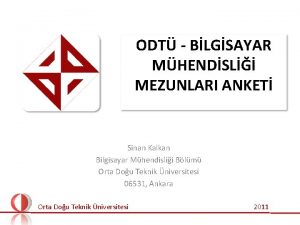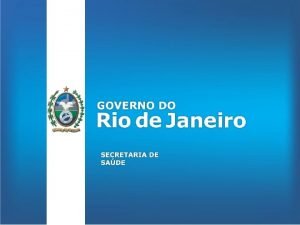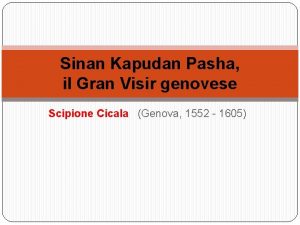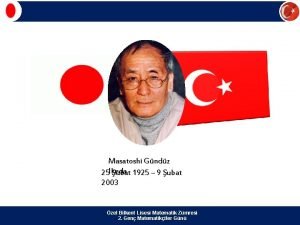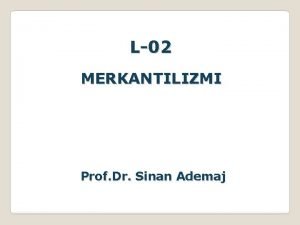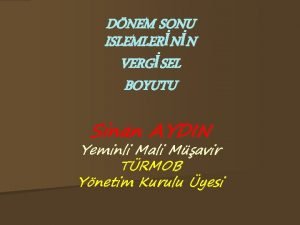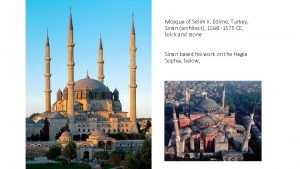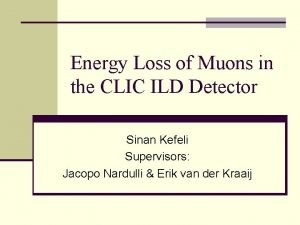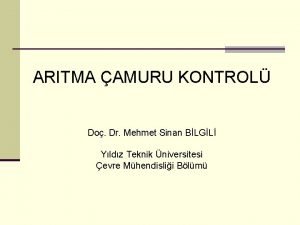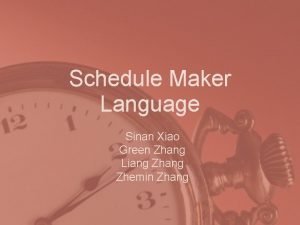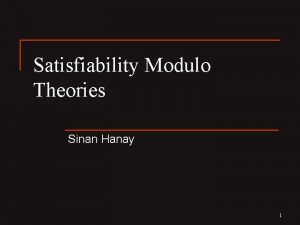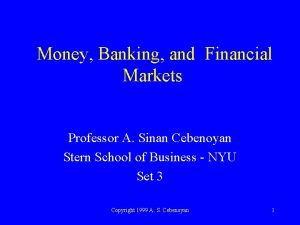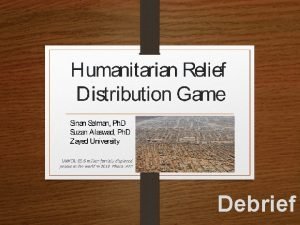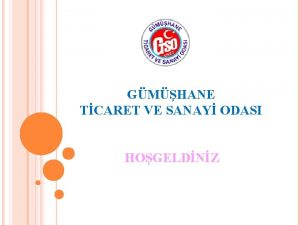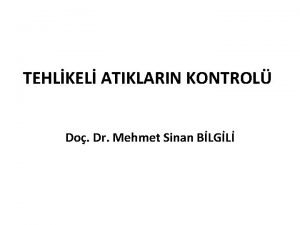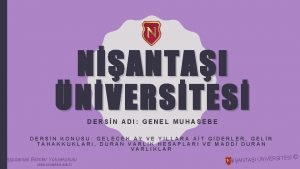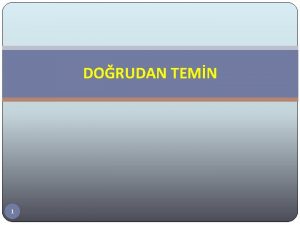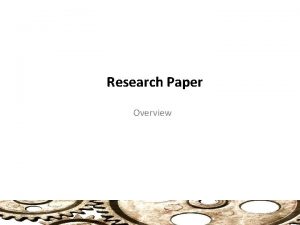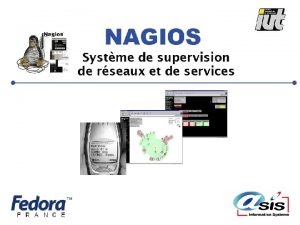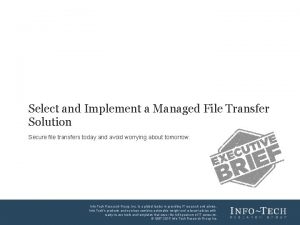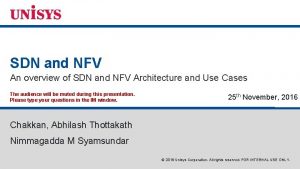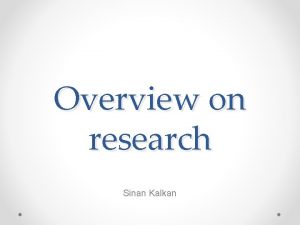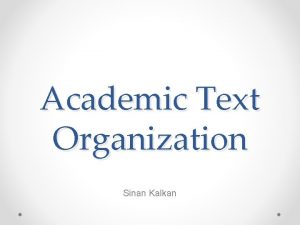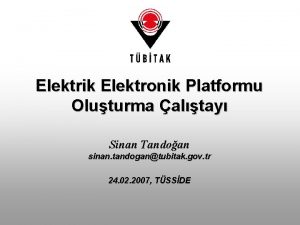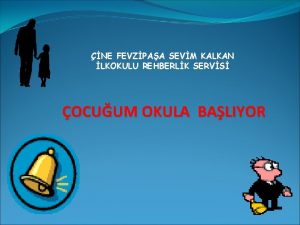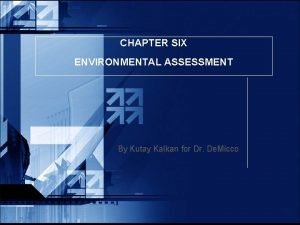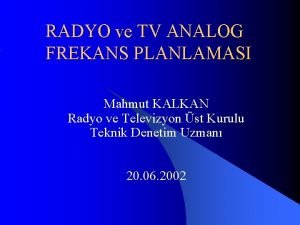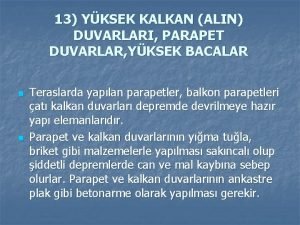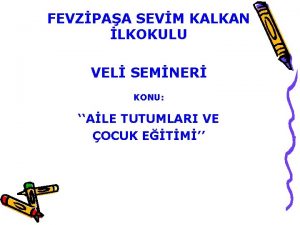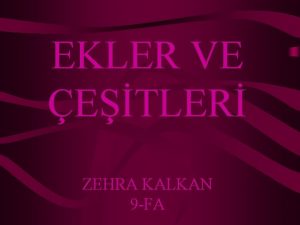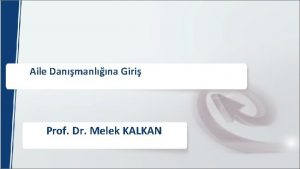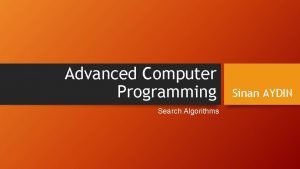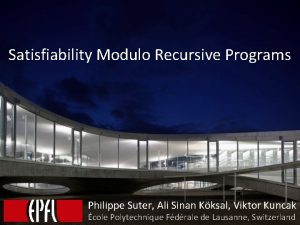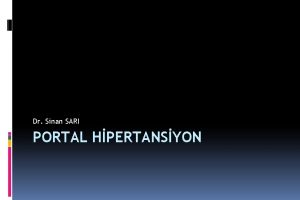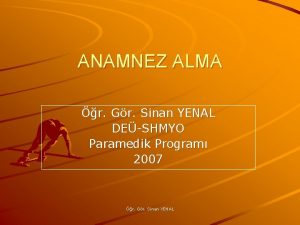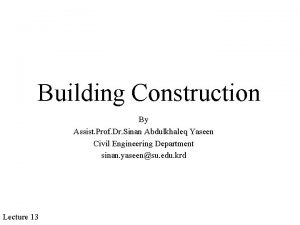Overview on research Sinan Kalkan What is research






































- Slides: 38

Overview on research Sinan Kalkan

What is research? • Find answers, solve problems o In M. Sc. , you take the first few steps on how to do research: novelty is not necessary but encouraged. o In Ph. D. , you are to prove that you can do research: novelty is a must. • The following are critical: o Analyzing data and the results: frog story. o Being precise and conclusive • In CS: a. b. c. d. Propose new solutions/algorithms to problems Compare algorithms/studies Collect data/dataset for studies Propose a formalism, theory, framework… CEng 591 - Sinan Kalkan September 21 2

An academic career Undergraduate degree Master of Science degree Doctor of Philosophy degree Assistant Professor Associate Professor CEng 591 - Sinan Kalkan September 21 3

What does an academician do? • Teach o Undergraduate courses o Graduate courses • Research o Direct projects in hot/new problems o Publish contributions o Attend conferences to present contributions • Administrative duties o Dept. Chair, Vice Chair, Committees etc. CEng 591 - Sinan Kalkan September 21 4

‘Good’ aspects of being an academician • • Money Time Infrastructure Flexibility Tourism Wide range of options Moral satisfaction Poor alternatives CEng 591 - Sinan Kalkan September 21 5

Doing “good” research • Limits: o Effort o Time o Money • Bad influences: o Publications/theses: quality vs. quantity • Advice: o Put a brick on an existing wall. CEng 591 - Sinan Kalkan September 21 6

Overview on writing Academic writing, thesis writing and ethical issues Sinan Kalkan

Why write? CEng 591 - Sinan Kalkan September 21 8

We write • • Technical reports Conference articles Journal articles Magazine articles Newspaper articles Books Theses CEng 591 - Sinan Kalkan September 21 9

Courtesy of Tom Gauld. CEng 591 - Sinan Kalkan September 21 10

Academic Writing • Important factors 1. Appearance • Spelling, grammar, formatting 2. Writing Style • Sentence flow 3. Organization • Connect the ideas 4. Content • The ideas Adapted from: www. sds. uwo. ca/writing CEng 591 - Sinan Kalkan September 21 11

Academic Writing: Be clear and precise • Be clear o Murphy’s law for academic writing: If it can be misinterpreted, it will misinterpreted. o Choose words wisely. Wrong words may mean ambiguity, misinterpretation etc. • Be precise o Avoid words that are unclear (e. g. , “good”, “bad”, “beautiful”) o Use descriptive, definite words o Examples: • “It was a good analysis” • “The analysis addressed three major concerns …” Adapted from: www. sds. uwo. ca/writing CEng 591 - Sinan Kalkan September 21 12

Academic Writing • Avoid absolute words o In academia, nothing is ever certain o Avoid “always”, “exactly”, “proves”, “never” etc. • Examples o “Figure 3 proves that …” o “Figure 3 shows that …” or “In Figure 3, we see that …” o “Deer mice never eat insects” o “Deer mice are not known to eat insects” Adapted from: www. sds. uwo. ca/writing CEng 591 - Sinan Kalkan September 21 13

Academic Writing • Check word meanings o English is a second language for us o Check meanings of words if in doubt • Many complications with prepositions especially: o Between: Comparing two things o Among: Comparing many things o Example: • I have a hard time choosing between Hamlet and Macbeth. • Among The Tempest, Othello and Julius Caesar, I would choose Othello. Adapted from: www. sds. uwo. ca/writing CEng 591 - Sinan Kalkan September 21 14

Academic Writing • • Affect vs. effect Lose vs. loose But vs. However So vs. Therefore Adapted from: www. sds. uwo. ca/writing CEng 591 - Sinan Kalkan September 21 15

Academic Writing • Be concise o o Shortening the text without impacting clarity Not the same as brevity Usually improves clarity If a word or phrase can be removed or shortened without losing meaning, do it • Repeating information o The end result, future plans o The result, plans • Unnecessary modifiers o Words that add little o Example: • Achieving peace without some kind of armistice is impossible. • Achieving peace without an armistice is impossible. Adapted from: www. sds. uwo. ca/writing CEng 591 - Sinan Kalkan September 21 16

Academic Writing • Unnecessary long descriptions o For the reason that o In light of the fact that o BECAUSE • Filler words like there is, there are, it is o There is evidence to suggest that fumigation causes. . . o Evidence suggests fumigation causes. . . • Proactive solutions o Active Voice o Positive Form o Subordination Adapted from: www. sds. uwo. ca/writing CEng 591 - Sinan Kalkan September 21 17

Academic Writing • Active voice o Subject is acting, not being acted upon o More direct and usually cuts out words o Examples: • Passive: The shoulder was rotated 70 degrees • Active: We rotated the shoulder 70 degrees • Passive: “In this thesis, a method for recognizing sign language gestures captured from a Kinect device is proposed” • Active: “I propose a method for recognizing sign language gestures captured from a Kinect device”. • Not used in all disciplines o Science: • Saline was added to treatment A. • I added saline to treatment A. • Treatment A contained saline. Adapted from: www. sds. uwo. ca/writing CEng 591 - Sinan Kalkan September 21 18

Academic Writing • Positive form o Convert negative phrases into positive o Eliminates phrases like “does not”, “will not” o Examples: • Method X does not perform very well on dataset A. • Method X performs better on dataset B. • Deer mice have not been shown to eat insects. • Deer mice primarily eat seeds and roots. • Subordination o Restructuring clauses within other clauses o Changes the relative importance, but also eliminates a lot of words o Examples: • The procedure was used to extract magnetite, and it took five steps. • The procedure was used to extract magnetite in five steps. • The five-step procedure was used to extract magnetite. • The five-step procedure extracted magnetite. Adapted from: www. sds. uwo. ca/writing CEng 591 - Sinan Kalkan September 21 19

In summary • Your text should be: o Concise/Precise/Specific o Clear o Elegant in every aspect CEng 591 - Sinan Kalkan September 21 20

CEng 591 - Sinan Kalkan September 21 21

CEng 591 - Sinan Kalkan September 21 22

Technical Details CEng 591 - Sinan Kalkan September 21 23

Format & Editor Credit: JL Blanco 1. 2. 3. 4. Use Latex If not possible, o • • Use Latex Templates are ready to use on fbe. metu. edu. tr There are very good editors available o o Tex. Studio & Te. Xnic. Center on Windows Eclipse, Kile etc. on Linux CEng 591 - Sinan Kalkan September 21 24

Figures, Equations, Tables etc. • Number your figures, tables, algorithms o And refer to them o Order them based on their referral order • Number your equations even if you don’t refer to them • Captions o Should be descriptive and precise o Captions are placed above tables and algorithms, and below figures CEng 591 - Sinan Kalkan September 21 25

Figures • Use scalable vector graphics • Not bitmap • SHOW EXAMPLE FILES CEng 591 - Sinan Kalkan September 21 26

Equations • Equations should be thought of as being part of the text • Therefore, they should end with a dot or a comma. CEng 591 - Sinan Kalkan September 21 27

Formal Explanation of a Method • CEng 591 - Sinan Kalkan September 21 28

Sorting: Problem definition • Sorting is the problem of rearranging the numbers such that they are in increasing order. CEng 591 - Sinan Kalkan • vs. September 21 30

Acronyms • • First introduce If in doubt, introduce If introduced, use it Don’t introduce if you don’t use it (e. g. , in abstract) Adapted from: www. sds. uwo. ca/writing CEng 591 - Sinan Kalkan September 21 31

References • Things are very easy in Latex o Use bibtex for organizing and using your references • FBE and journals have templates for this. Use them. • Google scholar is very useful in this aspect o DEMONSTRATION HERE CEng 591 - Sinan Kalkan September 21 32

Ethical Issues CEng 591 - Sinan Kalkan September 21 33

Collaboration & Attribution • Acknowledge your collaborators • Add them as authors if necessary o If in doubt, ask them • Author ordering is very critical. CEng 591 - Sinan Kalkan September 21 34

Research Mis-conduct • Use all results o Don’t hide data/results/datasets that are not in accordance with your hypotheses • Use correct results o Don’t use “painted” results • Don’t submit an article to multiple sources in parallel • Don’t argue/submit what you haven’t done • Cite everything that you use o Software, code, document, figure, table etc. CEng 591 - Sinan Kalkan September 21 35

Research misconduct • Video series: Do scientists cheat? • https: //www. youtube. com/watch? v=Vooa. LRq. TSPI CEng 591 - Sinan Kalkan September 21 36

Plagiarism • From Latin word plagiarius (~ kidnapper, stealer) • In Turkish, o «aşırma» , «intihal» . • From Wikipedia: o “Plagiarism is the "wrongful appropriation" and "stealing and publication" of another author's "language, thoughts, ideas, or expressions" and the representation of them as one's own original work. The idea remains problematic with unclear definitions and unclear rules. The modern concept of plagiarism as immoral and originality as an ideal emerged in Europe only in the 18 th century, particularly with the Romantic movement. ” o “Plagiarism is considered academic dishonesty and a breach of journalistic ethics. It is subject to sanctions like penalties, suspension, and even expulsion. ” o “Plagiarism is not a crime per se but in academia and industry, it is a serious ethical offense, [6][7] and cases of plagiarism can constitute copyright infringement. ” CEng 591 - Sinan Kalkan September 21 37

Plagiarism • Wikipedia: o “According to T. Fishman, plagiarism occurs when someone uses words, ideas, or work products: • Attributable to another identifiable person or source • Without attributing the work to the source from which it was obtained • In a situation in which there is a legitimate expectation of original authorship • In order to obtain some benefit, credit, or gain which need not be monetary” • Other definitions from different universities (Wikipedia): o "use, without giving reasonable and appropriate credit to or acknowledging the author or source, of another person's original work, whether such work is made up of code, formulas, ideas, language, research, strategies, writing or other form. “ o ". . . use of another's work, words, or ideas without attribution, “ o ". . . using a source's language without quoting, using information from a source without attribution, and paraphrasing a source in a form that stays too close to the original. “ o "deliberate" use of "someone else's language, ideas, or other original (not commonknowledge) material without acknowledging its source. “ CEng 591 - Sinan Kalkan September 21 38

Plagiarism • Wikipedia: “Common forms of student plagiarism: 1. 2. 3. 4. 5. 6. 7. 8. Submitting someone’s work as their own. Taking passages from their own previous work without adding citations. Re-writing someone’s work without properly citing sources. Using quotations, but not citing the source. Interweaving various sources together in the work without citing. Citing some, but not all passages that should be cited. Melding together cited and uncited sections of the piece. Providing proper citations, but fails to change the structure and wording of the borrowed ideas enough. 9. Inaccurately citing the source. 10. Relying too heavily on other people’s work. Fails to bring original thought into the text. ” CEng 591 - Sinan Kalkan September 21 39
 Sinan kalkan odtü
Sinan kalkan odtü Ihtilam
Ihtilam Sercan kalkan
Sercan kalkan Erol kalkan
Erol kalkan Sinan net fluxo de retorno
Sinan net fluxo de retorno Scipione cicala
Scipione cicala Gündüz ikeda hayatı
Gündüz ikeda hayatı Merkantilizmi
Merkantilizmi Sinan aydın mali müşavir
Sinan aydın mali müşavir Sinan
Sinan Sinan mosque of selim ii
Sinan mosque of selim ii Sinan alispahić
Sinan alispahić Sinan kefeli
Sinan kefeli Mehmet sinan bilgili
Mehmet sinan bilgili Sinan xiao
Sinan xiao Sinan hanay
Sinan hanay Sinan cebenoyan
Sinan cebenoyan Sinan salman
Sinan salman Sinan akıncı gümüşhane
Sinan akıncı gümüşhane Mehmet sinan atkın
Mehmet sinan atkın Sinan arsan
Sinan arsan Mehmet sinan koraltan
Mehmet sinan koraltan Review paper introduction
Review paper introduction Www description
Www description Maximo work order priority
Maximo work order priority Universal modelling language
Universal modelling language In uml is a connection among things
In uml is a connection among things Vertical retailer
Vertical retailer Figure 12-1 provides an overview of the lymphatic vessels
Figure 12-1 provides an overview of the lymphatic vessels Veins and arteries
Veins and arteries Texas public school finance overview
Texas public school finance overview Walmart operations management
Walmart operations management Stylistic overview of architecture
Stylistic overview of architecture Sa/sd and jsd
Sa/sd and jsd Spring framework overview
Spring framework overview Nagios tactical overview
Nagios tactical overview Market overview managed file transfer solutions
Market overview managed file transfer solutions Nfv vs sdn
Nfv vs sdn Sbic program overview
Sbic program overview
